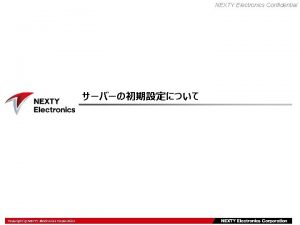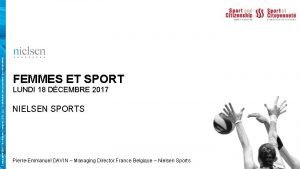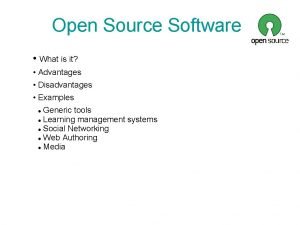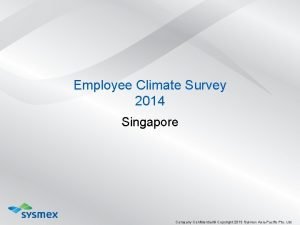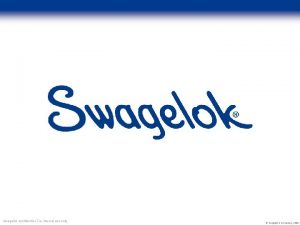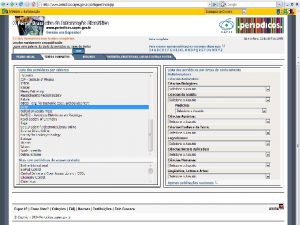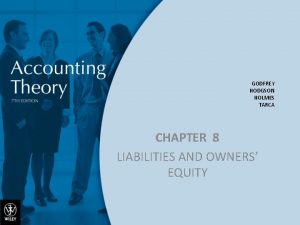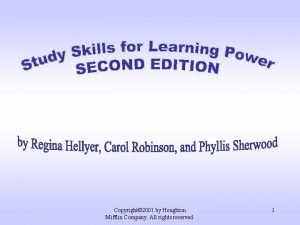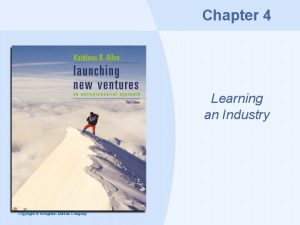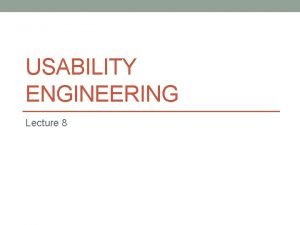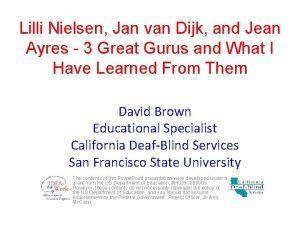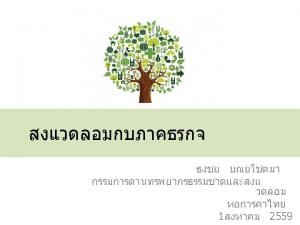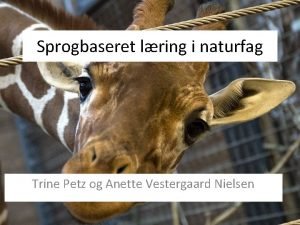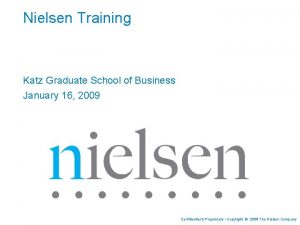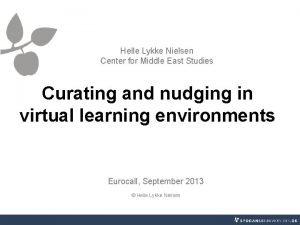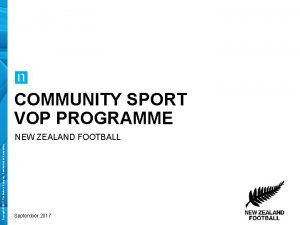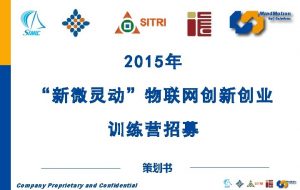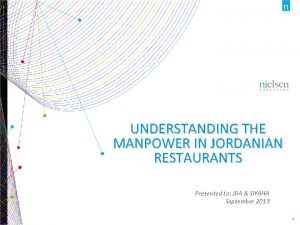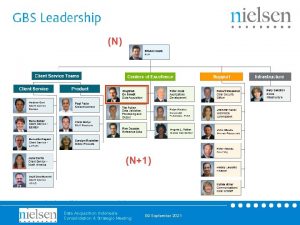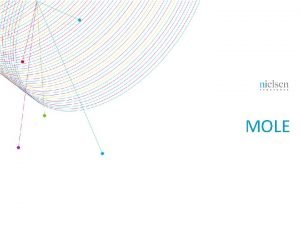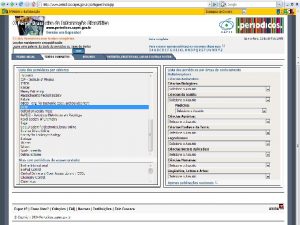Copyright 2017 The Nielsen Company Confidential and proprietary













































- Slides: 45

Copyright © 2017 The Nielsen Company. Confidential and proprietary. COMMUNITY SPORT VOP PROGRAMME SURF LIFE SAVING NEW ZEALAND June 2018

CONTENTS INTRODUCTION 3 EXECUTIVE SUMMARY 5 KEY METRIC RESULTS 8 MAIN FINDINGS 9 Copyright © 2017 The Nielsen Company. Confidential and proprietary. WHAT IS CAUSING THESE RATINGS? 19 LENGTH OF MEMBERSHIP & THE JOINING PROCESS 31 INJURY MANAGEMENT 35 DEMOGRAPHIC DIFFERENCES 39 REGION DIFFERENCES 46 ADDITIONAL VERBATIM COMMENTS 55 SAMPLE PROFILE 58 BACKGROUND, OBJECTIVES AND APPROACH 66 2

INTRODUCTION This report looks at the results for Surf Life Saving New Zealand to understand the club experience of their members in 2018. For more information about the background and objectives of the VOP Programme and this research please refer to the ‘Background, Objectives and Approach’ section. More than 11, 512 affiliated Surf Life Saving members had the opportunity to participate, with adults aged 16+ completing the questionnaire themselves (‘participants’) and parents/guardians (‘parents’) completing the questionnaire for children under the age of 16, on behalf of their child. When level of satisfaction is referenced in the report (i. e. the percentage who are ‘more than satisfied’), the top two results (‘very satisfied’ or ‘extremely satisfied’) of a positively skewed satisfaction scale are used (shown below). ‘MORE THAN SATISFIED’ Copyright © 2017 The Nielsen Company. Confidential and proprietary. EXTREMELY DISSATISFIED VERY SATISFIED EXTREMELY SATISFIED Positively skewed scales are used because the neutral ratings are divided between dissatisfaction and satisfaction (as opposed to a neutral mid point in a balanced scale). This gives the opportunity for some of the ‘very satisfied’ to be ‘delighted’, allowing for more variation/ greater discrimination compared with a balanced scale. In addition, a neutral option offers people an option not to think. If this is really true, then they have the ‘don’t know/ can't say’ option to select. Finally, in a competitive world today, is good…good enough? Good (or just satisfied) does not necessarily build strong relationships. We want members to rate their experience more than just satisfied, so they are real advocates and positively endorse their club and sport. 3

NOTES TO THIS REPORT STATISTICAL SIGNIFICANCE Statistically significant differences are highlighted or commented on in this report. Where no highlighting has been used (or no commentary about a sub-group included), it may safely be assumed that differences are not statistically significant or they are not pertinent. Statistically significant differences in this report are significant at the 95% confidence level. That is, we are 95% confident results are not just normal expected variances that result from talking to a different sample within the same population (note: the smaller the sample size, the higher the expected variance between samples and less likely that there will be statistically significant differences). Copyright © 2017 The Nielsen Company. Confidential and proprietary. Statistical significance is reported in the following ways: S �/ � s / The sub-group is significantly higher / lower than the Total Surf Life Saving result The Total Surf Life Saving result is significantly higher / lower than the total for All Sports 2017/18 TOTAL When comparing results, ‘cf. ’ is used as an abbreviation of ‘compare’. Throughout the report comparison with the total for ‘All Sports 2017/18’ is used. This is the total sample from 2017/18 i. e. an average of the sports that participated in winter 2017 and summer 2017/18. ROUNDING OF FIGURES Due to rounding, the net figures provided (e. g. % ‘very satisfied’ and % ‘extremely satisfied’) and total results may differ from the numbers shown on the charts. WEIGHTING No weighting was applied to these results. Please refer to the Sample Profile section to understand who responded. TOP TEAM OR HIGHER Top team or higher relates to respondents that have played for the top team at their club, represented the club at a regional event/competition, represented the region at a national event/competition and/or represented New Zealand at an International event/competition. 4

EXECUTIVE SUMMARY KEY METRICS Overall, surf life saving respondents are very positive about the experience at their surf life saving club. Compared to the total result for all sports 2017/18, surf life saving scores significantly higher four out of the five key metrics. • A significantly higher proportion of respondents are more than satisfied with the overall experience (73% cf. average for all sports of 63%). • A significantly higher proportion are likely to recommend their club to someone interested in participating in surf life saving (highlighted by a Net Promoter Score (NPS) of +63 cf. average for all sports of +44). • A significantly higher proportion are more likely to perceive value for money from their club (when compared with the average for all sports) (87% cf. average for all sports of 73%). That is; the opportunities, services and benefits they receive from their surf life saving club make it well worth the money they pay. • A significantly higher proportion are quite or very likely to rejoin their club next season (87% cf. average for all sports of 81%). Copyright © 2017 The Nielsen Company. Confidential and proprietary. However, new surf life saving joinees are significantly less likely to be more than satisfied with the process they went through when they joined the club (55% cf. average for all sports of 58%). DRIVERS OF THE CLUB EXPERIENCE Overall Surf Life Saving’s performance is relatively strong in the aspects important for respondents in their likelihood to recommend their club. The top three drivers of recommendation i. e. those that have the most impact on whether a respondent recommends their club to someone who is interested in participating in surf life saving are: 1. Being friendly and welcoming 2. Value for money 3. Is fair and provides equal opportunities for all participants However, is fair and provides equal opportunities for all participants is an area of focus due to the relatively low performance and above average importance of this driver. The lowest rated key driver is having clean and well maintained facilities, but this is a secondary priority for improvement (in terms of driving recommendation). 5

EXECUTIVE SUMMARY WHERE DO RESPONDENTS THINK CLUBS SHOULD INVEST (IF FEES INCREASED) When asked where clubs should invest, assuming any investment would require an increase in fees, a third (33%) of respondents would want their club to invest in facilities (e. g. club rooms, changing rooms and toilets). Participant development programmes (11%) and number of coaches/instructors (11%) areas next highlighted by respondents. The number of coaches/instructors being an area parents of children are significantly more likely to indicate (16%). One in ten (10%) indicated they would not want anything improved if it meant their fees were increased. REASON FOR BELONGING TO A CLUB Member motivations are quite varied. Overall, two in five mainly belong to a club to learn/improve skills (38%), with parents of children significantly more likely to indicate this (58%). This is followed by one in five (21%) indicating that they belong to have fun and one in ten belonging to participate competitively (11%). Copyright © 2017 The Nielsen Company. Confidential and proprietary. REASONS FOR CHANGING CLUBS (THOSE WHO HAVE BEEN A MEMBER OF ANOTHER CLUB) The predominant reason a member changed club is due to location (i. e. they’ve moved) (45%), while one in ten (9%) have changed club due to another club being more friendly and welcoming. COMPLAINTS Although there are relatively low levels of dissatisfaction with the overall experience among respondents (6% indicated they are dissatisfied or extremely dissatisfied), 6% indicated they have made a complaint to their club in the 3 months prior to this survey. INJURY Nine in ten (87%) avoided injury while participating or training in the last 12 months. This is significantly higher than the average for all sports in 2017/18 (87% cf. 80%). Parents are significantly less likely to indicate their child has been injured (8% cf. 16% participants) and they are also less likely to make an ACC claim following their child’s injury (39% cf. 56% participants). Just under half of respondents who continued to participate while injured as they didn’t think that the injury was that bad (47%) or because they simply wanted to continue participating (46%). 6

EXECUTIVE SUMMARY DIFFERENCES BETWEEN REGIONS The positive results for Surf Life Saving are seen equally across the four regions (Northern, Eastern, Central and Southern), with minimal differences for satisfaction, NPS, value for money, likelihood to rejoin and the joining process. DEMOGRAPHICS DIFFERENCES Overall, results vary amongst the key age groups, with stronger results seen for younger respondents. There is little difference between males and females, although males are significantly more likely to be more than satisfied with the process they went through when they joined (60% cf. 51%) Overall, those of Māori ethnicity are more satisfied with their club experience, and have a significantly higher NPS (+71 cf. +63). Copyright © 2017 The Nielsen Company. Confidential and proprietary. Asian and Indian respondents are the least satisfied and are significantly less likely to be more than satisfied with the joining process (33% cf. 55%). 7

KEY METRIC RESULTS HOW ARE SURF LIFE SAVING CLUBS PERFORMING? 87 73 63 87 81 73 63 55 58 44 SATISFACTION Copyright © 2017 The Nielsen Company. Confidential and proprietary. (Q 6: % more than satisfied) Almost three-quarters (73%) of respondents are more than satisfied with the overall experience of participating surf life saving at their club. This is significantly higher than the average for all sports in 2017/18. TOTAL SURF LIFE SAVING NPS (Q 7: % promoters less % detractors) Respondents are likely to recommend their current club to someone interested in participating in surf life saving, illustrated by a Net Promoter Score (NPS) of +63. This is significantly higher than the average for all sports in 2017/18. VALUE FOR MONEY LIKELIHOOD TO REJOINING PROCESS (Q 11: % agree or strongly agree) (Q 9: % quite likely or very likely) Nearly nine in ten (87%) respondents perceive value for money. That is; the opportunities, services and benefits they receive from their surf life saving club make it well worth the money they pay. This is a significantly higher proportion than the average for all sports in 2017/18. Nearly nine in ten (87%) respondents indicated they are likely to rejoin their current club next season. This is significantly higher than the average for all sports in 2017/18. (Q 20: % more than satisfied – average of 4 attributes) For new members (less than a year), just over half (55%) are more than satisfied with the process they went through when they joined their club. A significantly lower proportion than the average for all sports in 2017/18. ALL SPORTS 2017/18 Base: Q 6/Q 7/Q 9 All respondents (Excluding Don't know/not applicable), Q 9 All members (Excluding Don't know/not applicable), Q 20 New members (Excluding Don't know/not applicable) Q 6 (n=2670) / Q 7 (n=2683) / Q 11 (n=2615) / Q 9 (n=2630) / Q 20 (n=2500) (Average of four attributes) / Significantly higher/lower than All Sports 2017/18 8

MAIN FINDINGS Copyright © 2017 The Nielsen Company. Confidential and proprietary.

TWO IN FIVE BELONG TO A CLUB TO LEARN/IMPROVE SKILLS Two in five (38%) belong to a surf life saving club to learn/improve skills. 38% To learn/ improve skills 58%▲ 24%� Parents of participants (58%) are significantly more likely than participants (24%) to indicate that the main reason they belong to a surf life saving club is to learn/improve skills. One in five (21%) belong to have fun and one in ten (11%) belong to participate competitively. 21% To have fun 21% OTHER REASONS TO BELONG TO A CLUB INCLUDE: 22% “To official, so athletes have the opportunity to compete and become fitter, faster lifeguards. ” Participant, 50 -54 years, Bay of Plenty 11% To participate competitively 8%� 13%▲ 6% To get fit and healthy 6% Copyright © 2017 The Nielsen Company. Confidential and proprietary. 7% “To be fit and healthy, to meet new people and to have heaps of fun whilst competing. ” Parent of participant, 14 years, Bay of Plenty 5% To socialise 2%� 7%▲ To have access to facilities and equipment e. g. helmets, boards, boats 1% 0% 2%▲ 17% Other 5%� 25%▲ TOTAL SURF LIFE SAVING (n=2674) PARENT (n=1087) PARTICIPANT (n=1587) Base: All respondents who are members Q 4. What is the main reason you/ your child belong/ belongs to a surf life saving club? “To compete and have fun with her friends - at this age competition should not be the main priority. ” Parent of participant, 15 years, Gisborne “To learn about beach safety (it is at the end of our road) and the importance of contributing to your community. ” Parent of participant, 5 -7 years, Auckland “To keep my kids involved in surf sport and be part of a good environment. ” Parent of participant, 3539 years, Manawatu “To share my experience by providing volunteer time on the club committee and officiating sport events. ” Participant, 45 -49 years, Gisborne “To be there for the community, as I know I'm an able swimmer so I should use my skills to help others who are not so able. I am also passionate about first aid, as that knowledge can help you anywhere in life. ” Participant, 25 -29 years, Auckland �� Significantly higher/lower than Total Surf Life Saving 10

A FIFTH OF MEMBERS HAVE BEEN A MEMBER OF ANOTHER CLUB Almost half (45%) indicated that the main reason they changed club was because of location i. e. they moved. One fifth (20%) indicated an ‘other’ reason for changing clubs, including already being a member of another club or issues with staff members. REASON FOR CHANGING CLUB MEMBER OF ANOTHER CLUB 45% Location e. g. I/ we moved or the club moved The club was more friendly and welcoming 80% The opportunities were better to fulfil my/ their potential 7% Better quality of coaches or instructors 6% I know or knew someone at the club 5% 20% Better club management 2% Better social environment at the club 2% Copyright © 2017 The Nielsen Company. Confidential and proprietary. To change grades/ levels/ play in a different team Better access to equipment e. g. helmets, boards, boats No 9% Yes 2% 1% 20% Other Don't know or can't remember 1% ‘Other’ includes: ► Already a member at another club ► Joined friends at another club ► Issues with staff members ► Wanted to join a friendlier club Surf life saving respondents significantly more likely to have changed clubs are: Surf life saving respondents significantly less likely to have changed clubs are: ► ► ► Those who belong to have access to facilities (42%) or participate competitively (30%) Those whose focus for improvement is on the management of the club (28%) Those who participate or train 4+ times a week (28%) Detractors (27%) Males (22%). Base: All respondents who are members (n=2751) Q 31. Have/ Has you/ your child ever been a member of another surf life saving club? Base: All respondents who are members and used to belong to another club (n=483) Q 32. What is the main reason you/ your child changed surf life saving clubs? Those of Asian ethnicity (7%) Those who belong to learn/improve skills (9%) or have fun (15%) Those who participate or train once a week or less (14%) Those from the Central (15%) and Southern (16%) regions Promoters (16%) Females (17%). / Significantly higher/lower than All Sports 2017/18 11

CLOSE TO NINE IN TEN MEMBERS ARE LIKELY TO REJOIN THEIR CURRENT CLUB NEXT SEASON Only one in ten indicated they are unlikely or very unlikely to rejoin. Compared to the total for all sports, a significantly higher proportion of surf life saving members indicated that they are likely or very likely to rejoin (87% cf. 81%). 3%5% 5% 11% Somewhat Likely Very Likely Unlikely Likely Very Unlikely UNLIKELY OR VERY UNLIKELY TO REJOIN 76% Copyright © 2017 The Nielsen Company. Confidential and proprietary. 87% 85% 88% 8% 9% 8% 10% TOTAL SURF LIFE SAVING (n=2630) PARENT (n=1069) PARTICIPANT (n=1561) ALL SPORTS 2017/18 (n=27425) 81% LIKELY OR VERY LIKELY TO REJOIN LIKELIHOOD TO REJOIN Surf life saving respondents significantly more likely to rejoin are: Surf life saving respondents significantly less likely to rejoin are: ► ► ► ► ► New members who are satisfied with club introductions (93%) Those who participate or train 4+ times a week (92%) Those who are more than satisfied with their club (94%) Those who hold the role of coaches or instructors (94%) Those who haven’t complained in the last 3 months (88%). Base: All respondents who are members (Excluding Don't know/not applicable) Q 9. How likely are/ is you/ your child to participate for or rejoin <insert club from Q 2 a> next season? Those who are dissatisfied (39%) Those who disagree that their club provides value for money (40%) Those who haven’t complained in the last 3 months (72%) Those who participate or train once a week or less (77%) Those whose focus for improvement is the management of the club (78%) and quality of coaching (77%) ► Those aged 19 -29 (80%) ► Those who have been a member of another club (83%) ► Those who have been members for less than a year (84%). �� Significantly higher/lower than Total Surf Life Saving / Significantly higher/lower than All Sports 2017/18 12

THREE-QUARTERS ARE MORE THAN SATISFIED WITH THEIR CLUB EXPERIENCE Compared to the total for all sports, a significantly higher proportion are very or extremely satisfied (73% cf. 63%). Satisfaction is consistent across both children (as indicated by their parents/guardians) and participants themselves. 21% 41% Copyright © 2017 The Nielsen Company. Confidential and proprietary. 32% Satisfied Extremely satisfied Dissatisfied Very satisfied 75% 72% MORE THAN SATISFIED 4% 2% 73% 63% DISSATISFIED SATISFACTION WITH CLUB EXPERIENCE Extremely dissatisfied 6% 6% 6% 9% TOTAL SURF LIFE SAVING (n=2670) PARENT (n=1083) PARTICIPANT (n=1587) ALL SPORTS 2017/18 (n=28576) Surf life saving respondents significantly more likely to be more than satisfied are: Surf life saving respondents significantly less likely to be more than satisfied are: ► ► ► ► Promoters (88%) Those who hold the role of manager (85%) Those aged under 8 years (78%) and 8 -13 years (76%) Members for less than a year and 1 -2 years (77%) Those who represented their club at a regional event (77%) Those who belong to learn/ improve skills (76%). Detractors (5%) Those who disagree that their club provides value for money (15%) Those who have complained in the last 3 months (34%) Those whose focus for improvement is the management of the club (48%) Those who were injured for more than a month in the last 12 months (56%) Those aged 19 -29 years (67%) and 30+ years (69%) Members for 3 -5 years (70%). Base: All respondents (Excluding Don't know/not applicable) Q 6. To what extent are you satisfied or dissatisfied with the/ your child's overall experience of participating in surf life saving at your/ their club? �� Significantly higher/lower than Total Surf Life Saving / Significantly higher/lower than All Sports 2017/18 13

THREE-QUARTERS ARE ALSO LIKELY TO RECOMMEND THEIR CLUB Compared to the total for all sports, a significantly higher proportion are likely to recommend their club (72% cf. 60%). With a high proportion of promoters and few detractors (those not at all likely to recommend their club), Surf Life Saving has a relatively high Net Promoter Score (NPS) of +63 (cf. average of +44 for all sports in 2017/18). NPS: +63 10% +63 +62 +63 72% 73% 72% +44 60% Copyright © 2017 The Nielsen Company. Confidential and proprietary. 72% DETRACTORS PASSIVES PROMOTERS NPS = % PROMOTERS - % DETRACTORS PROMOTERS 18% 10% 9% TOTAL SURF LIFE SAVING (n=2683) PARENT (n=1086) PARTICIPANT (n=1597) 16% ALL SPORTS 2017/18 (n=28477) Surf life saving respondents significantly more likely to recommend their club are: Surf life saving respondents significantly less likely to recommend their club are: ► ► ► ► ► Hold the role of manager (89%) or club president (88%) Those who are more than satisfied with their club (87%) Those who identify as Māori (79%) Members for more than 10 years (76%). Those who disagree that their club provides value for money (21%) Those who have complained in the last 3 months (37%) Those who were injured for more than a month in the last 12 months (55%) Those who have been a member of another club (64%) Those aged 19 -29 (66%). Base: All respondents (Excluding Don't know/not applicable) Q 7. Imagine someone is interested in participating in surf life saving. If they asked you, how likely are you to recommend your/ your child's club to them, using a scale of 0 to 10 where 0 is not at all likely and 10 is extremely likely? �� Significantly higher/lower than Total Surf Life Saving / Significantly higher/lower than All Sports 2017/18 14

WHAT DO THEY LOVE ABOUT THEIR CLUB? Club spirit 22% 16% Coaching 11% People Copyright © 2017 The Nielsen Company. Confidential and proprietary. 30% 17% 15% 19% Family orientated 4% 23% Well organised: “Well organised, great communication and motivated teachers and parents” 17% 10% 10% Fun environme nt 10% 7% 4% 1% TOTAL SURF LIFE SAVING (n=1933) Other: “It is very inclusive, and the volunteers are fabulous. ” Club spirit: “I love the sense of community we have. ” 13% 5% 5% 5% Other Areas that respondents love about their club are similar between players and children (as indicated by their parents). However, parents are more likely to love coaching aspects of the club (23%) than players (11%). Players are more likely to love social aspects of the club (club spirit, family orientated, people) than parents of players. 11% Friendly and welcoming Well Organised 27% Coaching: “Great coaches that really encourage the kids” Family orientated: “They are very family focused and provide a great environment for the children” “The support you gain from everyone” 8% PARENT (n=786) Base: All respondents who gave an NPS score of 9 or 10 (n=363) Q 8 a. What is it that you love about your/ your child's club? PARTICIPANT (n=1147) Fun environment: “Not to serious, fun and challenging, very social. ” People: “The people and their attitude to life” Friendly and welcoming: “Very inclusive club friendly and community environment. ” 15

WHAT NEEDS TO IMPROVE TO INCREASE THE LIKELIHOOD OF RECOMMENDATION? Ideas of what needs to improve at their club vary between players and children (as indicated by their parents). Club environment Child focused Copyright © 2017 The Nielsen Company. Confidential and proprietary. Other 20% 22% 9% 9% Communication and organisation 8% 9% 8% Teams and competition Facilities and clubrooms TOTAL SURF LIFE SAVING (n=725) 44% 43% Players are more likely to want aspects of the club environment (more teams, more members, greater competition) to improve (44%) compared to parents (20%). Parents are more concerned with the focus being on children (43%) compared to players (9%). 12% 9% 14% Training Coaching 34% Other: “More time in the water and learning more about the ocean and the currents, tides, weather etc” 6% 6% 6% 4% 2% 6% Teams and competition: “More structure to the way things are run. making it easier to compete and patrol. ” PARTICIPANT (n=433) Base: All respondents who gave an NPS score of 0 -8 Q 8 b/c. What would need to improve at your/ your child's club to improve your rating? Coaching: “More experienced coaches and different options for competitive and non competitive members. ” Communication: “Better communication, especially around cancellations of practice etc” Child focus: “Have stages instead of ages so non confident kids can progress at their pace” 4% 3% 5% PARENT (n=292) Facilities and clubrooms: “Improve the facilities/ clubhouse. ” Club environment: “Change the way they treat people and manage the club better” Training: “More structure to competitive training e. g. having 1 dedicated coach. ” “The atmosphere, different groups in the club are very separate. ” 16

MORE THAN FOUR IN FIVE RESPONDENTS PERCEIVE VALUE FOR MONEY Compared to the total for all sports, a significantly higher proportion perceive value for money from their club (87% cf. 73%). The result is similar between participants and parents responding on behalf of their children. PERCEIVED VALUE FOR MONEY 89% 86% 73% AGREE OR STRONGLY AGREE 9% 1% 3% 87% 26% Somewhat agree Strongly agree Disagree Agree DISAGREE Copyright © 2017 The Nielsen Company. Confidential and proprietary. 61% Strongly disagree 4% 4% 4% 10% TOTAL SURF LIFE SAVING (n=2615) PARENT (n=1081) PARTICIPANT (n=1534) ALL SPORTS 2017/18 (n=24466) Surf life saving respondents significantly more likely to perceive value for money are: Surf life saving respondents significantly less likely to perceive value for money are: ► ► ► Promoters (95%) Those who belong to learn/ improve skills (90%) Those who are more than satisfied with their club (96%) Those whose focus for improvement is facilities (92%) Those aged 8 -13 years (90%). Base: All respondents (Excluding Don't know/not applicable) Q 11. To what extent do you agree or disagree with the following. . . Detractors (37%) Those who are unlikely to re-join their club next season (59%) Dissatisfied (35%) Those whose focus for improvement is the management of the club (72%) Those aged 19 -29 years (82%) and 30+ years (84%) Those who were injured for more than a month in the last 12 months (77%). �� Significantly higher/lower than Total Surf Life Saving / Significantly higher/lower than All Sports 2017/18 17

FEWER THAN ONE IN TEN MADE A COMPLAINT IN THE LAST THREE MONTHS Compared to the total for all sports, a slightly lower proportion have made a complaint (6% cf. 8%). Compared to parents, participants are significantly more likely to have made a complaint in the last three months (8% cf. 4%). MADE A COMPLAINT IN THE LAST THREE MONTHS 6% Copyright © 2017 The Nielsen Company. Confidential and proprietary. 94% 8% PARTICIPANT (n=1606) ALL SPORTS 2017/18 (n=24848) 4% ▼ 6% No 8% ▲ TOTAL SURF LIFE SAVING (n=2696) Yes PARENT (n=1090) Surf life saving respondents significantly more likely to have made a complaint are: Surf life saving respondents significantly less likely to have made a complaint are: ► ► ► ► Those who were dissatisfied (30%) Those whose focus for improvement is management of the club (24%) Those who belong to have access to facilities (23%) Those who hold the role of manager (18%) or committee member (15%) Those who were injured in the last 12 months (14%) Members for 6 -10 years (11%) and more than 10 years (13%) Those who participate or train 4+ times a week (11%) Those aged 19 -29 years (9%) and those aged 30+ years (11%). Base: All respondents (Excluding Don't know/not applicable) Q 19. Have you complained to your/ your child's club in the past 3 months? Those who are more than satisfied with their club (3%) Members for less than a year (2%) and 1 -2 years (3%) Those aged under 8 years (1%) and aged 8 -13 years (3%) Those who belong to learn/improve skills (4%) Those who train once a week or less (4%). �� Significantly higher/lower than Total Surf Life Saving / Significantly higher/lower than All Sports 2017/18 18

WHAT IS CAUSING THESE RATINGS? Copyright © 2017 The Nielsen Company. Confidential and proprietary.

DRIVERS OF THE CLUB EXPERIENCE The qualitative stage, undertaken as part of the development of the VOP questionnaire, identified seven drivers that influence club experience. After the initial pilot of the VOP questionnaire, these were expanded to nine core drivers. The question numbers that relate to each driver are shown below. BEING FRIENDLY & WELCOMING Q 10 a(R 1) SOCIAL ENVIRONMENT CLEAN & WELL MAINTAINED FACILITIES Q 10 a(R 9) Q 10 a(R 2) Copyright © 2017 The Nielsen Company. Confidential and proprietary. PROFESSIONAL & WELL MANAGED HAVING WELL MAINTAINED EQUIPMENT POSITIVE CLUB EXPERIENCE Q 10 a(R 8) Q 10 a(R 3) QUALITY OF COACHES FAIR & EQUAL OPPORTUNITIES Q 10 a(R 4) Q 10 a(R 7) FULFILLING POTENTIAL Q 10 a(R 6) PROVIDING INFORMATION WHEN NEEDED Q 10 a(R 5) 20

DRIVERS OF THE CLUB EXPERIENCE CONTINUED As well as the nine ‘core’ drivers of the club experience, based on the pilot results and in consultation with National Sporting Organisations (NSOs), the VOP survey also covers a number of secondary drivers. These are shown below with the associated question number. ► Value for money (Q 11) ► Encourages good sportsmanship and fair play (Q 10 b-R 1) ► The ease of accessing club equipment and facilities (Q 10 b-R 2) ► Fostering a sense of pride in the club (Q 10 b-R 3) ► Engaging with the local community (Q 10 b-R 4) ► Being responsive to needs and requirements (Q 10 b-R 5) ► Having qualified/ experienced officials available when I compete (Q 10 b-R 6) ► Providing a safe environment for adults and children (Q 10 b-R 7) Copyright © 2017 The Nielsen Company. Confidential and proprietary. ► Providing information and opportunities for officials development (Q 10 b-R 10) In addition, individual NSOs had the opportunity to add other drivers considered important or topical for their sport, if required. For Surf Life Saving New Zealand these were: ► Quality and variety of competitions and events regionally and nationally (Q 10 b-R 14) ► Making me / them aware of surf life saving courses and opportunities across New Zealand (Q 10 b-R 20). 21

EXPLANATION OF REGRESSION Regression analysis is a statistical process for analysing the relationship between two or more variables. It helps to understand the importance, or impact, of a ‘driver’ (the independent variable) by measuring its contribution to explaining variance in another variable (the dependent variable). Each independent variable is assigned a score ranging from zero to one - the closer to one, the more important/ impact it has on the dependent variable. We have used a regression approach called Modified Kruskal, which addresses any multi-collinearity issues. Nielsen has created a regression model unique to Surf Life Saving New Zealand. Copyright © 2017 The Nielsen Company. Confidential and proprietary. The dependent variable for the regression model is recommendation (the likelihood of a respondent to recommend their club to someone interested in participating in surf life saving). The independent variables are the attributes/ drivers in Q 10 a, Q 10 b and Q 11, including any optional or additional attributes. The following chart shows the impact of each attribute/ driver on a respondent’s likelihood to recommend their club. The importance or impact of a driver on recommendation is shown on the vertical axis along with the size of the bubble (from the regression model). How respondents are rating their satisfaction with each of the drivers, is shown on the horizontal axis. This allows us to see what is more important but rated lower - that is where clubs should focus, in order to improve recommendation. 22

DRIVERS OF RECOMMENDATION (NPS) The top three drivers of recommendation for surf life saving respondents are: PRIORITY FOR IMPROVEMENT STRENGTHS High 1. Being friendly and welcoming 2 1 Copyright © 2017 The Nielsen Company. Confidential and proprietary. 3. Is fair and provides equal opportunities for all participants Emphasis should be placed on improving the driver is fair and provides equal opportunities for all participants. This driver is in the priority for improvement quadrant, indicating high importance and low performance. Other areas in this quadrant are the social environment at the club, being professional and well managed and being responsive to my/their needs. IMPORTANCE OF DRIVER ON NPS 2. Value for money 7 6 8 10 14 18 19 16 15 17 Base: All Respondents (Excluding Don't know/not applicable) Q 7. Imagine someone is interested in participating in surf life saving. If they asked you, how likely are you to recommend your/ your child's club to them, using a scale of 0 to 10 where 0 is not at all likely and 10 is extremely likely? 13 11 Mean = 72% MAINTENANCE 90% PERFORMANCE (% MORE THAN SATISFIED) STRENGTHS 1. 2. 3. 4. 9 12 SECONDARY PRIORITY 50% 3 5 20 Low 4 PRIORITY FOR IMPOVEMENT Value for money 5. The social environment at the Being friendly and welcoming club Fostering a sense of pride Allowing me to fulfil my potential 6. Being professional and well managed 7. Is fair and provides equal opportunities for all participants 8. Being responsive to my/ their needs and requirements SECONDARY PRIORITY MAINTENANCE 9. Encouraging good sportsmanship and fair play 14. Providing the information when equipment and facilities 15. Engaging with the local community 16. Quality and variety of competitions 10. The quality of the coaches 11. The ease of accessing club 12. Having well maintained needed and events regionally and nationally 17. Having qualified/experienced equipment e. g. helmets, boards, officials available when I compete boats 18. Providing information and 13. Providing a safe environment for opportunities for officials adults and children development 19. Making me / them aware of surf life saving courses and opportunities across New Zealand 20. Having clean and well maintained 23

THE RELATIVE STRENGTH OF CLUBS IS BEING FRIENDLY & WELCOMING Surf life saving respondents have higher levels of satisfaction with the majority of the key drivers of club experience compared with All Sports 2017/18. Of the key drivers, respondents are least satisfied with having clean and well maintained facilities. % MORE THAN SATISFIED TOTAL SLS BEING FRIENDLY AND WELCOMING (n=2681) THE QUALITY OF THE COACHES OR INSTRUCTORS (n=2593) ALLOWING ME/ THEM TO FULFIL MY/ THEIR POTENTIAL (n=2590) Copyright © 2017 The Nielsen Company. Confidential and proprietary. HAVING WELL MAINTAINED EQUIPMENT E. G. HELMETS, BOARDS, BOATS (n=2604) 1% 4% 15% 28% 4% 1% 18% 52% 30% 80% 47% 77% 5% 1% 21% 34% 39% 73% 5% 1% 21% 36% 38% 73% PARTICALL SPORTS IPANT PARENT 2017/18 80% 81% 75%▼ 80%▲ 73% 74% 71%▼ 77%▲ 75% 61% 62% THE SOCIAL ENVIRONMENT AT THE CLUB (n=2616) 6% 1% 22% 39% 71% IS FAIR AND PROVIDES EQUAL OPPORTUNITIES FOR ALL PARTICIPANTS (n=2615) 2% 6% 21% 30% 40% 70% 68%▼ 74%▲ 63% BEING PROFESSIONAL AND WELL MANAGED (n=2663) 1% 6% 22% 70% 68%▼ 73%▲ 63% PROVIDING ME/ THEM THE INFORMATION I/ THEY NEED WHEN I/ THEY NEED IT (n=2663) HAVING CLEAN AND WELL MAINTAINED FACILITIES (n=2641) 1% 6% 34% 27% 11% 2% Extremely dissatisfied 36% 32% 31% Dissatisfied 34% 29% Satisfied Very Satisfied Base: All respondents (Excluding Don't know/not applicable) Q 10 a. How would you/ your child rate your/ their overall satisfaction with your/ their surf life saving club on each of the following… 26% 70% 71% 64% 66% 65% 67% 63% 55% 56% Extremely Satisfied �� Significantly higher/lower than Total Surf Life Saving / Significantly higher/lower than All Sports 2017/18 24

SATISFACTION: SECONDARY DRIVERS Performance in relation to the secondary drivers is also very positive, with all results that are comparable to the total for all sports 2017/18 significantly higher for Surf Life Saving. The areas they are least satisfied with relate to communication about information and opportunities. % MORE THAN SATISFIED TOTAL SLS PROVIDING A SAFE ENVIRONMENT FOR ADULTS AND CHILDREN (n=2667) ENCOURAGING GOOD SPORTSMANSHIP AND FAIR PLAY (n=2582) Copyright © 2017 The Nielsen Company. Confidential and proprietary. FOSTERING A SENSE OF PRIDE IN OUR/ THEIR CLUB (n=2610) 15% 1% 32% 1% 18% 2% 1% 3% 18% 83% 84% 82% 79% 79% 80% 71% 78% 77% 78% 67% 38% 73% 74% 72% 60% 38% 70% 69% 71% 45% 69% 70% 68% 54% 51% 31% 48% 32% PARTICALL SPORTS IPANT PARENT 2017/18 45% THE EASE OF ACCESSING THE CLUB EQUIPMENT & FACILITIES (n=2546) 1% 4% HAVING QUALIFIED / EXPERIENCED OFFICIALS AVAILABLE (n=1861) 1% 4% 25% ENGAGING WITH THE LOCAL COMMUNITY (n=2455) 1% 4% 26% QUALITY AND VARIETY OF COMPETITIONS AND EVENTS REGIONALLY AND NATIONALLY (n=2086) 1% 5% 27% 34% 33% 67% 66% - 1% 5% 27% 34% 32% 66% 67% 57% BEING RESPONSIVE TO MY/ THEIR NEEDS AND REQUIREMENTS (n=2587) 23% 35% 32% MAKING ME / THEM AWARE OF SURF LIFE SAVING COURSES AND OPPORTUNITIES ACROSS NEW ZEALAND (n=2242) 1% 7% 31% PROVIDING INFORMATION AND OPPORTUNITIES FOR OFFICIALS DEVELOPMENT (n=1838) 1% 7% 31% Extremely dissatisfied 35% 31% 32% Dissatisfied Satisfied 61% 30% Very Satisfied Base: All respondents (Excluding Don't know/not applicable) Q 10 b. How would you rate your/ your child's overall satisfaction with your/ their surf life saving club on each of the following. . . 60% 28% 65% � 54% ▼ 60% 61% 46% Extremely Satisfied �� Significantly higher/lower than Total Surf Life Saving / Significantly higher/lower than All Sports 2017/18 25

MEMBERS ARE LEAST SATISFIED WITH HAVING CLEAN AND WELL MAINTAINED FACILITIES. Respondents were asked to indicate the aspect they are least satisfied with. Being professional and well managed Copyright © 2017 The Nielsen Company. Confidential and proprietary. Results for participants and parents of participants are relatively consistent. Having clean and well maintained facilities is the least satisfied aspect for a quarter of both participants (27%) and parents (25%). However, one in ten participants (11%) indicated being professional and well managed as the aspect that they are least satisfied with, a significantly higher result than parents of participants (4%). While parents were significantly more likely to indicate they are least satisfied with providing me the information when I need it (13% cf. 4% participants). 26% 25% 27% Having clean and well maintained facilities e. g. clubrooms, changing rooms, toilets Providing me/ them the information I/ they need when I/ they need it 7% 7% 8% 4%▼ The quality of the coaches or instructors 5% 5% 5% 7% 9%� 5% 4% 6% Making me/ them aware of Surf Life Saving courses and opportunities across New Zealand 5% 5% 5% Allowing me/ them to fulfil my/ their potential 4% 5% 3% TOTAL SURF LIFE SAVING (n=883) 13%� 4%▼ Quality and variety of competitions and events regionally and nationally Value for money 11%� 7% Is fair and provides equal opportunities for all participants The social environment at the club 9% 4%▼ 4% 4% 3% PARENT (n=297) PARTICIPANT (n=586) Base: All respondents who are dissatisfied/extremely dissatisfied or disagree/strongly disagree (n=1885) Q 12 a. Thinking about what you rated lower in previous questions, please select which one aspect of your/ your child's club that you/ they are least satisfied with? Note: Only top ten areas shown �� Significantly higher/lower than Total Surf Life Saving 26

WHAT NEEDS TO IMPROVE FOR LOWER RATED ASPECTS Copyright © 2017 The Nielsen Company. Confidential and proprietary. “Create a culture that supports both competitive and non-competitive participants. At the moment, there is culture of younger people dominating the rooms (being loud playing on phones and taking over the room) and this is not welcoming. It's as though they have been allowed to 'take over' and they are not deliberately being difficult but it is sometimes a non-inviting space. ” Participant and Parent of Participant, 35 -39 years, Otago “Sponsorship opportunities and follow up info after lifeguard course completed and when other courses are available. ” Participant, 30 -34 years, Taranaki “A club strategic plan for the next 3 -5 years. Documented polices and procedures, and transparent and timely communications from the Executive Committee. That way as a member I know what, how, when and why my club is doing what it's doing over the medium to long term. And I know it has a clear vision and pathways for my child and her peers as they are introduced to the wonderful world of surf life saving. ” Participant and parent of Participant, 50 -54 years, Wellington “Encourage and support females in sport. Encourage involvement beyond only patrolling. Reducing the pressure of patrolling all the time and encourage sports training. Encourage female LEADERS in sport so it is less intimidating for females in the club who want to get involved at a lower level. ” Participant, 25 -29 years, Auckland “Be more culturally diverse and aware. Provide different Kai instead of the horrible cheap sausages and white bread. Incorporate some cultural tikanga into the running of the club. ” Participant and Parent of Participant, 40 -44 years, Auckland “For there to be recognition in terms of club membership fees for those who put considerable time into the club” Participant and Parent of Participant, 40 -44 years, Wellington “The coaches to be a bit more inclusive, encouraging and friendly. There wasn't any encouragement to enter the competitions. ” Participant, 11 -12 years, Auckland Base: All respondents who are dissatisfied/extremely dissatisfied or disagree/strongly disagree (n=1855) Q 12 b. What would you/ your child need from your/ their club to be more satisfied with <pipe in statement from Q 12 a>? “Better shower/change room and toilet facilities - cleaner, more light. More showers, a toilet separate from the shower (so it's not wet when you go to use it), decent hand basin and mirror. More coaching on those not strong enough to improve their weaknesses i. e. the nonconfident sea swimmer just gets pushed out with everyone else, there are no diagnostics to find out why they aren't confident and what can be done to help them improve. ” Parent of Participant, 8 -10 years, Auckland. 27

IF MEMBERSHIP FEES INCREASED, A THIRD OF RESPONDENTS WOULD WANT THEIR CLUB TO INVEST IN FACILITIES One in ten respondents (11%) would want this increased investment to be reflected in improvements to participant development programmes. Compared with participants (7%), a significantly higher proportion of parents (16%) would want this increased investment to be reflected in the number of coaches/instructors. Copyright © 2017 The Nielsen Company. Confidential and proprietary. Other top mentions include quality of equipment e. g. helmets, boards, boats (9%) and the quality of coaching/instructors (8%). 10% would not want anything improved if it meant their fees were increased. 33% 30% 34% Facilities e. g. club rooms, changing rooms, toilets 11% 11% Participant development programmes 11% Number of coaches or instructors 7%� 9% 9% 9% Quality of equipment e. g. helmets, boards, boats 8% 10%▲ 7%� Quality of coaching or instructors Management of the club 6% 7%▲ 5%� Social activities 6% 4%� 7%▲ Quality of officiating Other TOTAL SURF LIFE SAVING Base: All respondents (Excluding Don’t Know/ Not applicable) (n=2135) Q 14. If your/ your child's surf life saving club was going to focus on improving one of the following aspects, and the membership fees increased to reflect this investment, which would be the one thing you/ your child would like them to improve? 7% 3%� 9%▲ Communications Access to equipment e. g. helmets, boards, boats 16%▲ 4% 4% 4% 1% 0% 1% 5% 4% 5% PARENT (n=828) PARTICIPANT (n=1307) �� Significantly higher/lower than Total Surf Life Saving 28

INVESTMENT AREAS (IF FEES INCREASED) Those who are significantly more likely to indicate they would want improvement in the following areas, if fees were to increase: 33% FACILITES E. G. CLUB ROOMS, CHANGING ROOMS, TOILETS ► Those who are extremely satisfied with their Copyright © 2017 The Nielsen Company. Confidential and proprietary. club (39%) ► Promoters (37%) ► Those who are likely to rejoin their club next season (34%). REGIONS OVER / UNDER ▲ Northern (38%) ▼ Eastern (29%) 11 11% PARTICIPANT DEVELOPMENT PROGRAMMES % NUMBER OF COACHES OR INSTRUCTORS ► Those who are paid employees of a club (26%) ► Those who are likely to rejoin their club next ► Those who are unlikely to rejoin their club next season (16%) ► Those who belong to learn/improve skills (15%) ► Those who are likely to rejoin their club next season (12%). ► Parents of participants (16%) ► Those aged under 8 (16%) ► Those aged under 14 (15%). REGIONS OVER / UNDER ▼ Central (9%) Base: All respondents (Excluding Don’t Know/ Not applicable) (n=2135) Q 14. If your/ your child's surf life saving club was going to focus on improving one of the following aspects, and the membership fees increased to reflect this investment, which would be the one thing you/ your child would like them to improve? Note: Top six areas shown season (20%) REGIONS OVER / UNDER ▲ Central (14%) �� Significantly higher/lower than Total 2017/18 29

INVESTMENT AREAS (IF FEES INCREASED) Those who are significantly more likely to indicate they would want improvement in the following areas, if fees were to increase: 9% 8% 7% QUALITY OF EQUIPMENT QUALITY OF COACHING OR INSTRUCTORS MANAGEMENT OF THE CLUB ► Those who belong to participate competitively Copyright © 2017 The Nielsen Company. Confidential and proprietary. ► ► ► (18%) Those who identify as Pasifika (18%) Those aged under 19 (17%) Those who train/participate 4+ times a week (16%) Those aged under 16 (14%) Those who have been a member for 3 -5 years (13%). REGIONS OVER / UNDER ▲ Central (15%) ► ► Detractors (16%) Those who belong to learn/improve skills (15%) Those aged under 8 (13%) Parents of participants (10%). ► Those who are extremely dissatisfied with their club (24%) ► Detractors (19%) ► Those who are unlikely to rejoin their club next season (13%) ► Those who have been members for more than 10 years ► ► ► REGIONS OVER / UNDER (11%) Those aged 19 -29 years (11%) Those aged 30+ years (10%) Those who are participants and parents (10%) Those who have been members for 6 -10 years (10%) Participants (9%) Those who have been a member of another club (9%). REGIONS OVER / UNDER ▼ Northern (7%) ▼ Eastern (6%) Base: All respondents (Excluding Don’t Know/ Not applicable) (n=2135) Q 14. If your/ your child's surf life saving club was going to focus on improving one of the following aspects, and the membership fees increased to reflect this investment, which would be the one thing you/ your child would like them to improve? Note: Top six areas shown �� Significantly higher/lower than Total 2017/18 30

LENGTH OF MEMBERSHIP & THE JOINING PROCESS Copyright © 2017 The Nielsen Company. Confidential and proprietary.

KEY METRICS: LENGTH OF MEMBERSHIP Aside from likelihood to rejoin, results tend to be highest among new members (less than a year), with overall satisfaction and perceived value for money significantly higher compared to the total. OVERALL SATISFACTION 77%� NPS 70%� 70% 73% TOTAL 73% 64 66 57� 66 TOTAL 63 61 LESS THAN 1 YEAR (n=628) 1 -2 YEARS (n=454) 3 -5 YEARS (n=711) 6 -10 YEARS (n=407) MORE THAN 10 YEARS (n=448) Copyright © 2017 The Nielsen Company. Confidential and proprietary. LIKELIHOOD TO REJOIN 84%� LESS THAN 1 YEAR (n=622) LESS THAN 1 YEAR (n=634) 1 -2 YEARS (n=456) 3 -5 YEARS (n=712) 6 -10 YEARS (n=409) MORE THAN 10 YEARS (n=450) VALUE FOR MONEY 86% 88% 88% 1 -2 YEARS (n=449) 3 -5 YEARS (n=706) 6 -10 YEARS (n=409) MORE THAN 10 YEARS (n=444) Base: All respondents who are members (Excluding Don't know/not applicable) Q 6 / Q 7 / Q 9 / Q 11 TOTAL 87% 90%� LESS THAN 1 YEAR (n=625) 89% 1 -2 YEARS (n=448) 87% 3 -5 YEARS (n=702) 84%� 6 -10 YEARS (n=405) 85% TOTAL 87% MORE THAN 10 YEARS (n=414) �� Significantly higher/lower than Total Surf Life Saving 32

DIFFERENCE IN LENGTH OF MEMBERSHIP Those who are significantly more likely to be in the following tenure groups: 24% 17% 27% 15% 17% NEW MEMBERS 1 -2 YEARS 3 -5 YEARS 6 -10 YEARS MORE THAN 10 YEARS ► Those who identify as ► ► ► Copyright © 2017 The Nielsen Company. Confidential and proprietary. ► ► Asian (45%) or Pasifika (36%) Those who belong to learn/ Improve skills (35%) Those who train once a week or less (35%) Those who don’t want anything to improve if it means fees increase (29%) Those whose focus for improvement is access to equipment (26%) Female (26%). ► Those who identify as ► Those whose focus for Asian (29%) ► Those who belong to learn/ Improve skills (24%) ► Those who train once a week or less (21%). improvement is quality of equipment (37%) ► Those who belong to participate competitively (32%). ► Those who belong to have ► ► ► ► REGIONS OVER / UNDER ▲ Central ▼ Eastern (29%) ▲ Northern (28%) (18%) ▼ Southern (19%) REGIONS OVER / UNDER Base: All respondents who are members (n=2674) Q 3. How long have/ has you/ your child been a member of <insert club from Q 2 a>? REGIONS OVER / UNDER access to facilities (35%), socialise (26%) and to participate competitively (24%) Those who participate or train 4+ times a week (30%) Those who hold the role of coach, manager or committee member (26%) Those who have complained in the last 3 months (25%) Those who were injured in the last 12 months (24%) Those who are dissatisfied with their club (21%) Detractors (20%) Those who identify as Māori (19%). REGIONS OVER / UNDER ▲ Eastern (21%) ► Those who were injured for more than a month (38%) ► Those who belong to socialise (33%) ► Those who have complained in the last 3 months (33%) ► Those who moved clubs as their new club was more friendly (29%) ► Those who participate or train 4+ times a week (24%) ► Male (22%). REGIONS OVER / UNDER ▼ Northern (13%) �� Significantly higher/lower than Total 2017/18 33

OVER HALF OF NEW MEMBERS ARE SATISFIED WITH THE JOINING PROCESS One-quarter (24%) have been members of their current club for less than a year. When asked about the individual aspects they went through when they joined their club, these respondents provided attribute ratings ranging from 48% to 60% more than satisfied. Compared with parents, participants are significantly more likely to indicate they are more than satisfied with each of the attributes. NEW MEMBERS (Less than 1 year) TOTAL PARTICI- PARENT ALL SPORTS SLS PANT 2017/18 Ease of the joining process (n=632) Providing information on how to join (n=627) 24% Copyright © 2017 The Nielsen Company. Confidential and proprietary. 76% No Yes % MORE THAN SATISFIED SATISFACTION WITH THE JOINING PROCESS Explaining protocols, how to play, use facilities, location venues, selection, how it works, etc (n=621) Introducing you/ you or your child to key people at the club e. g. coaches, admin staff, etc (n=620) Extremely dissatisfied 1% 6% 34% 26% 6% 34% 29% 2% 11% 35% 2% 10% Dissatisfied Satisfied 21% Very Satisfied Base: All respondents who are members (n=2674) Q 3. How long have/ has you/ your child been a member of <insert club from Q 2 a>? Base: All respondents who have been members for less than one year (Excluding Don't know/not applicable) Q 20. Thinking about the process you/ you and your child went through when you/ your child joined your/ their surf life saving club. How satisfied are you with your/ their club on the following… 67%� 56%� 66% 60% 66%� 57%� 59% 26% 52% 59%� 49%� 53% 27% 48% 57%� 44%� 52% 31% 27% 40% 60% 34% Extremely Satisfied �� Significantly higher/lower than Total Surf Life Saving / Significantly higher/lower than All Sports 2017/18 34

INJURY MANAGEMENT Copyright © 2017 The Nielsen Company. Confidential and proprietary.

IN THE LAST 12 MONTHS, ONE IN TEN PARTICIPANTS HAVE BEEN INJURED Nine in ten (87%) avoided injury while participating or training in the last 12 months. This is significantly higher than the average for all sports in 2017/18 (87% cf. 80%). Parents are significantly less likely to indicate their child has been injured (8% cf. 16% participants) and they are also less likely to make an ACC claim following their child’s injury (39% cf. 56% participants). INJURED IN THE LAST 12 MONTHS MADE AN ACC CLAIM, FOLLOWING THE INJURY 13% 52% 48% Copyright © 2017 The Nielsen Company. Confidential and proprietary. 87% No or Can’t remember Yes YES NO Surf life saving respondents significantly more likely to have been injured are: Surf life saving respondents significantly less likely to have been injured are: ► ► ► ► Those who moved club to fulfil their potential (33%) Those who complained in the last 3 months (27%) Those who participate or train 4+ times a week (27%) Those who belong to participate competitively (25%) Those aged under 16 years (24%) or 19 -29 years (21%) Those who have been members for 6 -10 years (20%). Those aged under 8 years (2%) Those who have been members for less than a year (6%) Those who participate or train once a week or less (6%) Those who do not represent the top team at their club (7%) Those who reside in the Southern region (9%) Those who belong to lean/ improve skills (9%) Males (11%). Base: All respondents (n=2696) Q 17. Have/ Has you/ your child been injured while participating or training for surf life saving in the last 12 months? Base: All respondents who have been injured in the last 12 months (n=342) Q 17 a. Following the injury you/your child sustained while participating or training for surf life saving, did you/ your child make an ACC claim? �� Significantly higher/lower than Total Surf Life Saving / Significantly higher/lower than All Sports 2017/18 36

INJURY MANAGEMENT Around seven in ten respondents are more than satisfied with the how their club managed their injury, with all three attribute ratings significantly higher than the average for all sports in 2017/18. Participants (74%), more so than parents (68%), are more than satisfied with the club not pushing them back into participating or training too soon (cf. 73% total). % MORE THAN SATISFIED TOTAL PARTICISURF LIFE SAVING PANT Not pushing you/ them back into participating or training too soon (n=278) Copyright © 2017 The Nielsen Company. Confidential and proprietary. Continuing to involve you/ your child in club activities while you/ they were injured (n=264) Supporting you/ your child while you/ they recovered from an injury (n=273) 2% 3% 22% 2% 3% 2% 6% 25% 26% 27% 25% Extremely dissatisfied 46% 44% 27% Dissatisfied Satisfied 40% Very Satisfied PARENT ALL SPORTS 2017/18 73% 74% 68% 66% 70% 71% 68% 64% 67% 68% 66% 60% Extremely Satisfied �� Significantly higher/lower than Total Surf Life Saving Base: All respondents who have been injured in the last 12 months (Excluding Don't know/can’t remember) Q 18. How satisfied are you with your/ your child's surf life saving club, coach, instructor or manager on the following… / Significantly higher/lower than All Sports 2017/18 37

TWO IN FIVE CONTINUE TO PARTICIPATE OR TRAIN DESPITE INJURY Just under half of respondents who continued to participate while injured as they didn’t think that the injury was that bad (47%) or because they simply wanted to continue participating (46%). TIME MISSED DUE TO INJURY 8% WHY DID THEY CONTINUE TO PARTICIPATE WHILE INJURED 47% They didn’t think injury was that bad 7% 46% They wanted to continue playing 38% 11% 16% They didn’t want to let the team down They didn’t want to let the coach down 5% The coach wanted me/them to play 1% Copyright © 2017 The Nielsen Company. Confidential and proprietary. 33% More than 3 months None 1 – 3 months Less than 2 weeks 18% Other Don't know or can't remember 2 – 4 weeks 2% ‘Other’ includes: ► Short on participants ► Wasn’t serious/ injury could not worsen by participating ► Was in a competition Surf life saving respondents significantly more likely to continue to participate while injured are: Surf life saving respondents significantly less likely to continue to participate while injured are: ► ► ► ► ► Those who have been members for less than a year (62%) Those who participate or train once a week or less (56%) Those aged 8 -13 years (57%) Those not in the top team at their club (45%) Those who reside in the Northern region (47%). Those who have been members for more than 5 years (30%) Those who participate or train 4+ times a week (29%) Those who participate in the top team or higher at their club (33%) Those who reside in the Southern region (21%). Base: All respondents who have been injured in the last 12 months (Excluding Don't know/not applicable) (n=342) Q 38. In the last 12 months, how much time did you/ your child have to take off from participating due to your/ their injury? Base: All respondents who continued to participate even when injured (n=129) Q 39. Why did you/ they continue to participate while you/ they were injured? �� Significantly higher/lower than Total Surf Life Saving 38

DEMOGRAPHIC DIFFERENCES Copyright © 2017 The Nielsen Company. Confidential and proprietary.

RESULTS ARE MIXED ACROSS KEY AGE GROUPS Results are typically strongest across the younger age groups. SATISFACTION NPS (% more than satisfied) (% promoters less % detractors) 89 78 LIKELIHOOD TO REJOIN (% agree or strongly agree ) (% quite likely or very likely) 90 88 90 82 76 76 88 84 86 87 89 JOINING PROCESS (% more than satisfied – average of 4 attributes ) 88 82 76 75 67 Copyright © 2017 The Nielsen Company. Confidential and proprietary. VALUE FOR MONEY 69 67 65 62 59 64 63 54 51 68 52 52 ) ) ) ) ) ) ) ) 8* 47 41 44 45 28 33 97 13 16 97 49 22 99 48 10 91 46 55 08 95 43 54 15 36 33 30 27 42 40 -2 1 -2 53 - n=2 40 - 52=3 n=8 n=2 n=1 n=3 n=7 =3 n=8 n=2 n=1 n=3 n=6 =3 n=8 n=2 n=1 n=3 n=7 0 n n ( 1 3 ( ( ( ( ( = ( ( ( ( = =2 =2 6 (n U 19 9 (n + (n U 8 U 14 U 16 U 19 9 -29 30+ (n 4 (n 1 2 0 8 1 1 3 U 9 U U 1 1 KEY SURF LIFE SAVING AGE BRACKETS JUNIORS (U 8) (7 & under) JUNIORS (U 14) (8 -13 years) SENIORS (U 16) (14 -15 years) SENIORS (U 19) (16 -18 years) Base: Q 6/Q 7/Q 11 All Respondents (Excluding Don't know/ Can't say), Q 9 Members (Excluding Don’t know/Can’t say), Q 20 New Members (Excluding Don't know/ Can't say) Q 6 / Q 7 / Q 11 / Q 9 / Q 20 (Average of four attributes) OPEN (19 -29 years) MASTERS (30+) �� Significantly higher/lower than Total Surf Life Saving 40

KEY DIFFERENCES: AGE BRACKETS Compared to the Total Surf Life Saving result, respondents in the following age brackets are significantly more likely to be: ► Participating in surf life ► Copyright © 2017 The Nielsen Company. Confidential and proprietary. ► ► saving once a week or less (93%) To be more than satisfied with the quality of the coaches/instructors (83%) To be more than satisfied that their club has well maintained equipment (80%) To be more than satisfied that their club is fair (79%) To be more than satisfied overall with their club (78%) More likely that their main reason for belonging is to learn/improve skills (62%). ► More likely to agree ► ► ► that their club provides value for money (90%) To be more than satisfied that their club is friendly and welcoming (83%) To be more than satisfied that their club has well maintained equipment (79%) To be more than satisfied overall with their club (76%) More likely that their main reason for belonging is to learn/improve skills (57%) More likely to participate in surf life saving once a week or less (54%). Base: All Respondents (n=2751) Q 22. In which of the following age groups do/ does you/ your child belong? SENIORS (U 19) SENIORS (U 16) JUNIORS (U 14) JUNIORS (U 8) ► To be more than ► ► satisfied with the joining process (64%) More likely to participate in surf life saving four times or more a week (38%) To have been injured in the last 12 months (24%) More likely that their main reason for belonging is to participate competitively (19%) More likely If fees were to increase, to want focus for improvement to be the quality of equipment (14%). ► To be more than ► ► satisfied with the social environment at their club (81%) To be more than satisfied with the joining process (75%) To be more than satisfied that their club has clean and well maintained facilities (64%) Those whose main reason for belonging is to have fun (32%) or to participate competitively (16%) More likely If fees were to increase, to want focus for improvement to be the quality of equipment (17%). OPEN (19 -29 YRS) ► To be more than ► ► ► satisfied with the joining process (68%) More likely to participate in surf life saving four times or more a week (39%) More likely to have been a member of another club (33%) More likely that their main reason for belonging is to participate competitively (22%) or to socialise (9%) More likely to be detractors (13%) More likely If fees were to increase, to want focus for improvement to be the management of the club (11%). MASTERS (30+) ► More likely to have been a member of another club (37%) ► More likely to participate in surf life saving two or three times a week (30%) ► More likely If fees were to increase, to want focus for improvement to be the management of the club (10%) ► More likely to not be satisfied with their club (9%). 41

RESULTS ARE SIMILAR BY GENDER Males are significantly more satisfied with the process they went through when they joined. SATISFACTION NPS (% more than satisfied) (% promoters less % detractors) VALUE FOR MONEY LIKELIHOOD TO REJOINING PROCESS (% agree or strongly agree ) (% quite likely or very likely) (% more than satisfied – 87 64 Copyright © 2017 The Nielsen Company. Confidential and proprietary. 62 ) 78 E L MA (n 85 E FE L MA 86 74 73 3 =1 88 87 average of 4 attributes ) (n 2 =1 ) ) 81 E L MA (n 3 =1 LE MA E F 60 ▲ ) (n ) 36 95 2 =1 E L MA 3 =1 (n ) E L MA (n FE Base: Q 6/Q 7/Q 11 All Respondents (Excluding Don't know/ Can't say), Q 9 Members (Excluding Don’t know/Can’t say), Q 20 New Members (Excluding Don't know/ Can't say) Q 6 / Q 7 / Q 11 / Q 9 / Q 20 (Average of four attributes) ) 48 72 2 =1 E L MA 3 =1 (n E L MA FE ) 76 2 =1 51 ▼ 9) 2) 29 (n E AL M 94 =2 (n E AL 3 -3 22 =3 (n M FE �� Significantly higher/lower than Total Surf Life Saving 42

KEY DIFFERENCES: GENDER MALE Copyright © 2017 The Nielsen Company. Confidential and proprietary. Male respondents are significantly more likely than females to: ► Have not been injured in the last 12 months (87%) ► More likely to be more than satisfied that their club allows me to fulfil my potential (75%) ► More likely to be more than satisfied that their club is fair and provides equal opportunities for all participants (72%) ► More likely to be more than satisfied with the joining process (60%) ► More likely to have not made an ACC claim in the last 12 months (56%) ► More likely to be aged 30+ (37%) ► More likely to have been a member of another club (22%) ► More likely to be a participant and the parent of a participant (18%) ► More likely to be a coach/instructor (12%), hold the role of club president or another office (6%) or be a manager (3%) ► More likely that their main reason for belonging is to have access to facilities and equipment e. g. helmets, boards, boats (2%). Base: All Respondents (n=2751) Q 25. Are/ Is you/ your child…? FEMALE Female respondents are significantly more likely than males to: ► Be only a participant at their club (88%) ► More likely to be more than satisfied that their club has well maintained equipment e. g. helmets, boards, boats (75%) ► More likely to have made an ACC claim in the last 12 months (59%) ► More likely to be a parent of a participant (43%) ► More likely that their main reason for belonging is to learn/improve skills (40%) and to have fun (23%) ► More likely to be aged under 14 (34%), under 16 (13%), under 19 (7%) or aged 19 -29 (15%) ► More likely to have been a member for less than a year (26%) ► More likely to have been injured in the last 12 months (14%) ► More likely to identify as Māori (13%). 43

OVERALL, THOSE OF MĀORI ETHNICITY ARE MORE SATISFIED WITH THEIR CLUB EXPERIENCE Asian and Indian respondents tend to be less positive about their surf life saving experience. Asian and Indian respondents are the least satisfied and are significantly less likely to be more than satisfied with the joining process (33% cf. 55%). SATISFACTION NPS (% more than satisfied) (% promoters less % detractors) � 74 74 71 66 VALUE FOR MONEY LIKELIHOOD TO REJOIN (% agree or strongly agree) (% quite likely or very likely) 87 88 92 86 87 88 82 JOINING PROCESS (% more than satisfied – average of 4 attributes) 82 � 71 63 58 63 56 56 62 Copyright © 2017 The Nielsen Company. Confidential and proprietary. � 33 ) ) ) ) ) 01 00 00 07 91 71 72 72 71 50 50 49 91 50 03 71 11 26 62 76 n= n= n= 21 (n=2 24 (n=3 23 (n=3 =1 ( ( ( ( ( n = = = ( A A N (n (n (n AN AN RI RI RI IK IK KA DI DI IF IF HA ĀO HA ĀO FI I N N N S S E E E I I I S M M M & PA N & AK AK AK PA N /P /P /P IA IA IA N N N S S S A A A EA EA EA OP OP OP R R R EU EU EU Base: Q 6/Q 7/Q 11 All Respondents (Excluding Don't know/ Can't say), Q 9 Members (Excluding Don’t know/Can’t say), Q 20 New Members (Excluding Don't know/ Can't say) Q 6 / Q 7 / Q 11 / Q 9 / Q 20 (Average of four attributes) �� Significantly higher/lower than Total Surf Life Saving 44

KEY DIFFERENCES: ETHNICITY Compared to the Total Surf Life Saving result, respondents of the following ethnicities are significantly more likely to: EUROPEAN / PAKEHA ► Belong to have fun (93%) ► Want communications improved (96%) ► Be aged 19 -29 (94%) ► Hold the role of coach (94%). MĀORI Copyright © 2017 The Nielsen Company. Confidential and proprietary. PASIFIKA ASIAN & INDIAN ► Have represented New Zealand at an international event (21%) ► Be a member of their club for 6 -10 years (19%) ► Belong to get fit and healthy (16%) ► Aged U 16 (15%) ► Be from the Eastern region (14%). ► A member of their club for less than a year (36%) ► Can’t remember if they were injured in the last 12 months (9%) ► Want quality of equipment improved (5%) ► Be from the Northern region (3%). ► A member of their club for less than a year (47%) ► Aged under 19 years (4%) ► Be from the Northern region (3%). Base: All Respondents (n=2751) Q 34. Which ethnic group or groups do/ does you/ your child identify with or belong to? Note: Respondents can identify with more than one ethnicity, therefore results may add up to more than 100%. 45
 Blancco oy
Blancco oy Confidential & proprietary
Confidential & proprietary Nexty electronics corporation
Nexty electronics corporation Confidential copyright
Confidential copyright The nielsen company us llc
The nielsen company us llc Advantages and disadvantages of oss
Advantages and disadvantages of oss Confidential company profile
Confidential company profile Confidential company profile
Confidential company profile Confidential company hyderabad
Confidential company hyderabad Worldwide logistics
Worldwide logistics Company confidential singapore
Company confidential singapore Microsoft second internaluseonly distro
Microsoft second internaluseonly distro Company confidential profile
Company confidential profile Copyright secondary sara (2017) answers
Copyright secondary sara (2017) answers Proprietary freeware
Proprietary freeware Proprietary grief
Proprietary grief Proprietary format
Proprietary format Define proprietary colony
Define proprietary colony Proprietary theory
Proprietary theory Copyright houghton mifflin company
Copyright houghton mifflin company Copyright houghton mifflin company
Copyright houghton mifflin company Customer mix manager
Customer mix manager Copyright houghton mifflin company
Copyright houghton mifflin company Copyright houghton mifflin company
Copyright houghton mifflin company Consolidated balance sheet meaning
Consolidated balance sheet meaning Multinational vs transnational
Multinational vs transnational Nielsen and chuang solutions chapter 4
Nielsen and chuang solutions chapter 4 Private company vs public company
Private company vs public company Company act 1994
Company act 1994 What type of company was the virginia company
What type of company was the virginia company Usability engineering jakob nielsen
Usability engineering jakob nielsen Morten nielsen dtu
Morten nielsen dtu Aree nielsen
Aree nielsen Lilli nielsen
Lilli nielsen Numeric distribution nielsen
Numeric distribution nielsen Amrld
Amrld Radio audience measurement survey
Radio audience measurement survey Jon kjær nielsen
Jon kjær nielsen 2015 nielsen global corporate sustainability report
2015 nielsen global corporate sustainability report Nielsen cps
Nielsen cps Trine petz
Trine petz Michael nielsen quantum
Michael nielsen quantum Ole taggaard nielsen
Ole taggaard nielsen Nielsen data training
Nielsen data training Cbs dtu
Cbs dtu Lykke og helle nielsen
Lykke og helle nielsen


